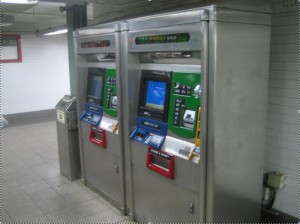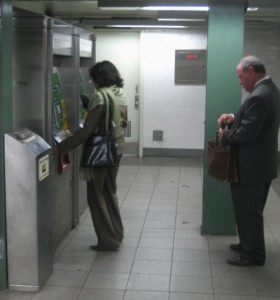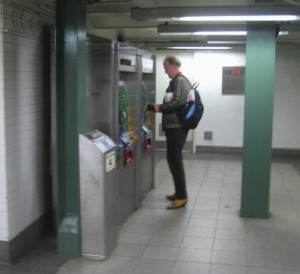Observation of Interaction – MetroCard Vending Machine (10/21/2009)
Observation 1 – Conducting research in a public place in New York City is not as easy as it use to be. Now that Big Brother is watching for terrorist threats, any time you hang out in one area, you are immediately suspicious. I knew that I wanted to watch people interact with MetroCard Vending Machines in the Subway, but finding my research spot proved to be difficult. The first spot I selected, the Broadway Lafayette station, had three police officers with a searching table set up next to the vending machine, so I got back on the subway. Next I went to Prince Street, but at that station there were Armed Guards changing the money in the vending machine, so I didn’t think they would want me hanging around either. Finally I ended up in a good spot at 14th Street Union Square.

Observation 2 – Staking out my spot at the tail end of the rush hour commute, I imagined that the flow of people would be moderate, but not overwhelming. It turned out that very few people needed to use the vending machine, as they already had a positive balance on their MetroCard. It is interesting to note that there are many chances to use something like an ATM, Vending Machine of Food, and other similar interfaces, most people seem to use the MetroCard machine infrequently.
Observation 3 – Users of the machine looked visibly confused and/or frustrated. Navigating the many choices seemed okay, but when it came time to pay, inserting cash and getting a credit card to swipe and be approved seemed to really slow things down. One person completed the transaction in 30 seconds, but most took 40 seconds to 60 seconds to get their card and be on their way.

Observation 4 – Most people inserted their current MetroCard to add money, which implies that they were existing users of this system and not first-time users. Despite their prior use, they seemed equally frustrated, delayed, and unsure of what to do. Again, the payment part of the process seemed to be the bottleneck.

Observation 5 – Although there were two machines next to each other, frequently there would be several people waiting to use one machine, while the other was left free. And several people canceled their transaction midway only to move to the adjacent machine to try again.
Observation 6 – Before MetroCard Vending Machines existed, the only way to buy a metrocard (or token) was to visit the ticket booths with ticket agents. My guess was that the vending machines were put into place to automate this process, saving the city money by having less wage workers on the clock and saving the end user time by reducing transaction time and line waiting. Assuming these were the goals, this has not been a successful change of service and behavior. Many users first went to the ticket booth, only to find that they had to use the vending machine. Other users started off at the vending machines, but then went to ticket booth for help, only to return to the vending machine. Clearly the machines are not easy to use and the ticket agents have been recast as technical troubleshooters, possibly a function they have not been trained in or that they do not want to perform.
In this video, you can watch as one women has an awful time getting her MetroCard, only to then seek help from the ticket agent, and finally to give up and leave empty handed.
MetroCard Vending Machine – Reserach and Observation from Noah King on Vimeo.
